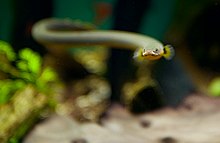Reedfish
| Reedfish | |
|---|---|

| |

| |
| Scientific classification | |
| Domain: | Eukaryota |
| Kingdom: | Animalia |
| Phylum: | Chordata |
| Class: | Actinopterygii |
| Order: | Polypteriformes |
| Family: | Polypteridae |
| Genus: | Erpetoichthys J. A. Smith , 1865
|
| Species: | E. calabaricus
|
| Binomial name | |
| Erpetoichthys calabaricus J. A. Smith , 1865 | |

| |
| Synonyms[2][3] | |
| |
The reedfish, ropefish (more commonly used in the United States), or snakefish, Erpetoichthys calabaricus, is a
Description
The largest confirmed reedfish museum specimen was 37 cm (15 in) long,[4][5] and three studies where more than 2,000 wild reedfish were caught (using basket traps, meaning that only individuals longer than 15–20 cm [6–8 in] were retained) found none that exceeded 41.4 cm (16.3 in).[6][7][8] Although sometimes claimed to reach up to 90 cm (3 ft) long,[9][10] this is incorrect.[11]
Body elongation in fishes, such as eels, usually happens through the addition of caudal (tail) vertebrae, but in
The
Distribution and habitat
The reedfish inhabits slow-moving or standing, fresh or
Ecology
The reedfish is
Females repeatedly deposit small batches of eggs between the anal fins of the male, where they are fertilized. The male reedfish then scatters the eggs among aquatic vegetation, where they stick to plants and substrate. Larvae hatch rapidly (after 70 hours) but remain attached to vegetation; they become independent and start to feed after ~22 days, when the egg's yolk sac has been consumed.[4]

Conservation
In coastal central Africa, the species is threatened by
In the aquarium
Reedfish are sometimes displayed in aquaria. All aquarium fish are wild-caught; they have not yet been successfully bred in captivity. Spawning and hatching in captivity has been observed, but no hatchlings have been reported to survive to adulthood.[5][19]
They are inquisitive, peaceful, and have some "personality". Although nocturnal, reedfish will sometimes come out during the day. Since they have a peaceful nature, other fish may "bully" a reedfish, despite its large size, especially in competition for food or space.[20] Some reedfish also have an inclination to stay close to the water surface, where they will be safe from other fish and will even allow most of their bodies to leave the water at times.[citation needed]
They can be difficult to keep; they will jump and enter pumps to escape tanks and frequently die as a result, and they can be sensitive to pH swings and nitrogen chemistry.
See also
References
- ^ . Retrieved 19 November 2021.
- ^ Froese, R.; Pauly, D. (2017). "Polypteridae". FishBase. Retrieved 18 May 2017.
- ^ "Polypteridae" (PDF). Deeplyfish- fishes of the world. Retrieved 18 May 2017.
- ^ a b c d e Froese, Rainer; Pauly, Daniel (eds.) (2014). "Erpetoichthys calabaricus" in FishBase. March 2014 version.
- ^ a b "A breeding first: The Reedfish". Practical Fishkeeping. Retrieved 16 June 2022.
- ^ King, R.P. (1996). "Length-weight relationships of Nigerian freshwater fishes". The WorldFish Center. 19 (3): 49–52.
- ^ Ekpe, A.I.; Asikpo, E.-I. M. (2019). "Sex ratio, size structure and condition index in the rope fish, Erpetoichthys calabaricus (Polypteridae) from a Niger Delta flood plain, Nigeria". International Journal of Fisheries and Aquatic Studies. 7 (1): 205–209.
- ^ a b Amiekan, N.A.; Udo, M.T.; Brownson, I.I.; Obot, O.I.; Ekpo, I.E. (2020). "Population dynamics of Calabar snakefish (= reed fish), Erpetoichthys calabaricus. (Teleostei: Polypteridae) (Smith, 1866) at Ibikpe Creek in Uruan, Nigeria". Journal of Wetlands and Waste Management. 4 (1): 66–77.
- ^ "Erpetoichthys calabaricus". SeriouslyFish. Retrieved 16 June 2022.
- ^ a b "Understanding the Reedfish". TFH Magazine. Retrieved 16 June 2022.
- ^ .
- ^ Effects of Precaudal Elongation on Visceral Topography in a Basal Clade of Ray-Finned Fishes
- ^ a b Asuquo, I.E.; Essien-Ibok, M.A. (2019). "Sexual Dimorphism in Erpetoicthys calabaricus from a Mangrove Creek, Nigeria". Asian Journal of Fisheries and Aquatic Research. 2 (3): 1–9.
- ^ Fishelson, L. (1984). Zoology. Vol. 2. Israel: Hakibutz Hameuchad Publishing House. p. 126.
- ^ Milner, J. (4 October 2021). "Rope Fish Profile: Care, Tanking and Feeding". The Aquarium Club. Retrieved 16 June 2022.
- ^ Locomotor flexibility of Polypterus senegalus across various aquatic and terrestrial substrates
- PMID 21270300.
- ^ Terrestrial capture of prey by the reedfish, a model species for stem tetrapods
- ^ "Reed Fish - Maidenhead Aquatics".
- ^ a b c A profile of Ropefish Retrieved 2 August 2017.
- ^ Phil Purser (August 2007). "Understanding the Reedfish". Tropical Fish Magazine.
- ^ "Erpetoichthys calabaricus". The Age of Aquariums. Retrieved 2 August 2017.

